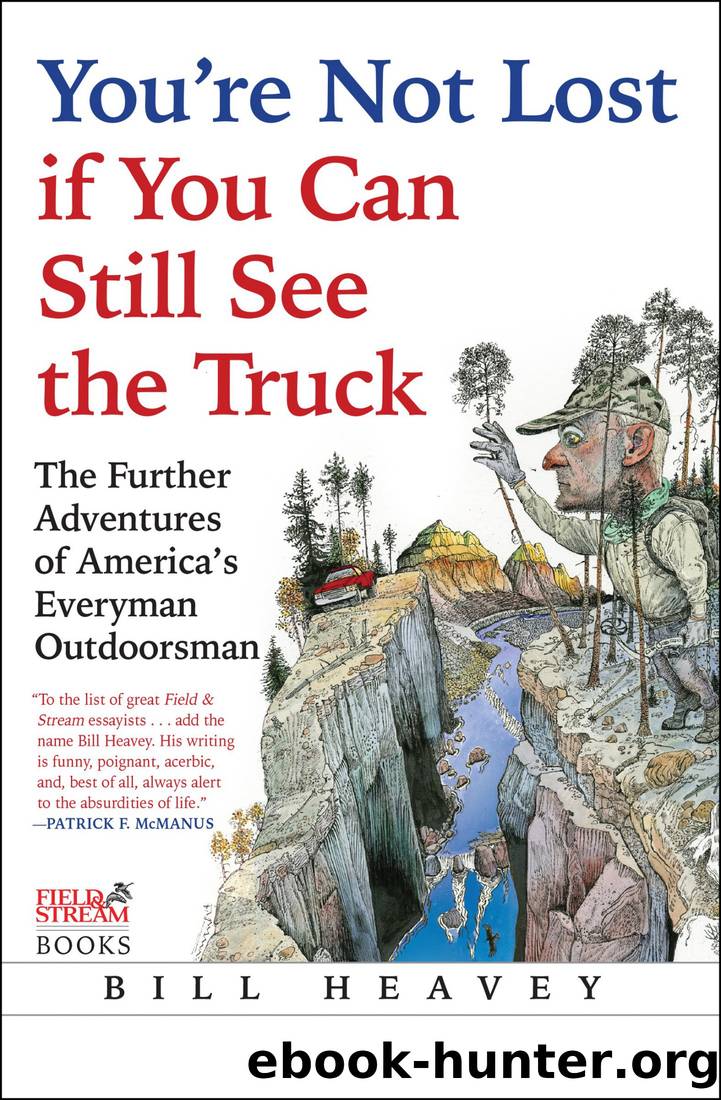You're Not Lost if You Can Still See the Truck_The Further Adventures of America's Everyman Outdoorsman by Bill Heavey

Author:Bill Heavey [Heavey, Bill]
Language: eng
Format: epub
Tags: Humour, Writing, Travel
ISBN: 9780802123022
Amazon: B00JLQ4O5G
Goodreads: 21535673
Publisher: Atlantic Monthly Press
Published: 2014-12-02T00:00:00+00:00
AS GOOD AS IT GETS
Just when it seems like everybody you know is sharpening their elbows in the great national Race to the Bottom of the Toilet, you run across a guy who didnât even fill out the entry form. Grayson Chesser lives in Virginia on the Eastern Shore, the narrow spit of land separating the Chesapeake Bay from the Atlantic Ocean. Near as he can tell, his people landed a few miles down the beach in the 1600s and never found a good reason to leave. He lives on land farmed by his great-grandfather and great-great-grandfather.
âYou could make a good living here for quite a long time, you know,â he says. âChesapeake was good for fishing, crabbing, oystering. The soil was rich. And the waterfowl hunting was as good as anywhere on earth.â Chesser went to Old Dominion University, got a degree in business, and was in the process of losing his shirt farming when he decided to go into decoy carving and guiding full-time.
The decision paid off. Chesser isnât trading in his twelve-year-old truck anytime soon, but heâs not going back to farming, either. Of the two hundred or so decoys he makes each year, most are sold before he even gets around to carving them. Collectors snap up a lot, but about 20 percent are bought by guys who have the audacity to put them in the water and hunt over them, as does Chesser himself.
Chesserâs decoysâwhich he carves in species from teal to ÂCanadasâare made of pine, cedar, and other types of wood. (You may remember wood, that hard, fibrous stuff that was once used to make bows, boats, rifle stocks, fishing lures, and countless other needful things. Itâs now used primarily to frame town houses on what was recently hunting property.)
âItâs nice to win ribbons,â he says of the contemporary carving scene. âBut itâs nothing compared to watching some birdâthat was maybe born up near the Arctic Circle and can go anywhere in the world it wantsâcup its wings and come in to the decoys you made. Thatâs all I ever really wanted out of life, to be able to carve and see that, and to hunt and guide.â
Itâs healthy to do work you love. At fifty-six, Chesserâs black hair is untouched by gray. The lower part of his face is permanently tanned. His forehead, usually shielded by his cap, is as white as milk. His mind is quick but his speech is slow, and his movements slower still. There is about him the aura of a historically misplaced person, someone who one day woke to find himself in the twenty-first century, cut his eyes left and right, and decided the best move was not to let it bother him too much.
Chesser killed his first duck at the age of twelve over three of his fatherâs old decoys, including one made of papier-mâché that had a broken bill. âThat was it for me,â he remembers. âHunting over decoys was addictiveâlike how people talk about their first hit of crack.
Download
This site does not store any files on its server. We only index and link to content provided by other sites. Please contact the content providers to delete copyright contents if any and email us, we'll remove relevant links or contents immediately.
Backpacker the Complete Guide to Backpacking by Backpacker Magazine(2193)
Capital in the Twenty-First Century by Thomas Piketty(1944)
The Isle of Mull by Terry Marsh(1892)
Predation ID Manual by Kurt Alt(1653)
The Collected Non-Fiction by George Orwell(1570)
Small-Bore Rifles by C. Rodney James(1502)
All Fishermen Are Liars by John Gierach(1443)
Backcountry Bear Basics by Dave Smith(1433)
Creative Confidence by Tom Kelley(1413)
The Art of Throwing by Amante P. Marinas Sr(1353)
50 Famous Firearms You've Got to Own by Rick Hacker(1338)
Archery: The Art of Repetition by Simon Needham(1301)
Blood Mountain by J.T. Warren(1301)
Long Distance Walking in Britain by Damian Hall(1278)
The Scouting Guide to Survival by The Boy Scouts of America(1247)
Backpacker Long Trails by Backpacker Magazine(1245)
The Fair Chase by Philip Dray(1224)
The Real Wolf by Ted B. Lyon & Will N. Graves(1209)
The Ultimate Guide to Home Butchering by Monte Burch(1200)
